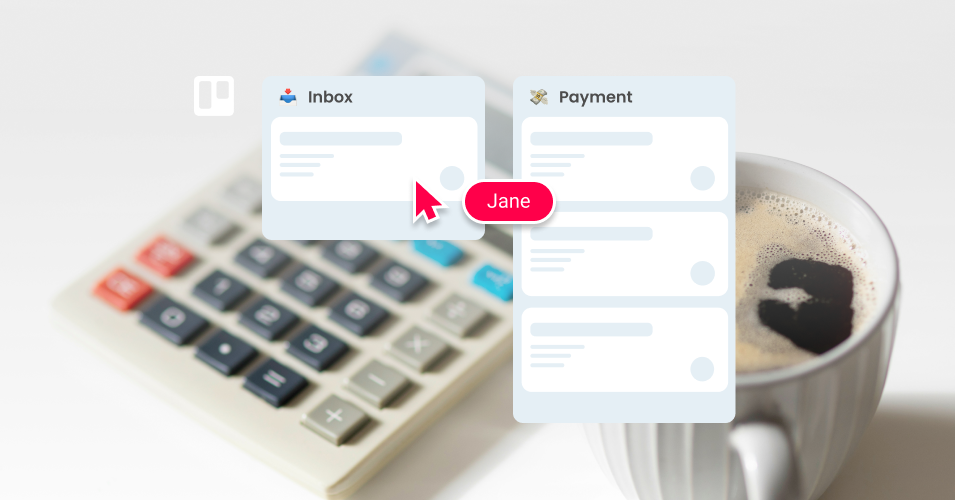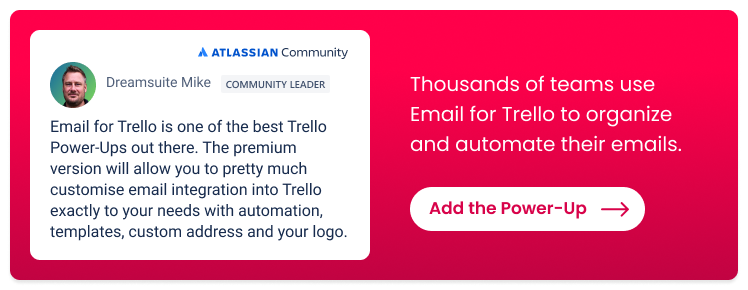10 ways to become an invoicing pro in Trello
Be the boss of your finance admin in Trello! Manage your invoices, bills and email conversations in one central dashboard with the Email for Trello Power-Up.
If you’re looking for an effective way to manage your invoicing processes, Trello is a powerful and adaptable platform to consider. Its flexible layout of ‘cards in lists’ helps you visualize your bills and invoices, as well as streamline the processes in your finance workflow.
Plus, with the Email for Trello Power-Up, you can connect your finance inbox (i.e. accounts@) so that your admin team can engage with suppliers via email – right from Trello.
Read on for our top 10 tips for invoice management in Trello.
10 ways to become an invoicing pro in Trello
1. Organize your finance processes with Kanban
Trello’s visual system of ‘cards in lists’ is based on the Kanban methodology. For finance teams, each card represents a bill or invoice, and each list is a different stage of your workflow. This helps you to track and visualize the progress of invoices as they move from left to right through your pipeline – from receipt to payment and filing.
An example of a Kanban workflow. It’s a bit like a dynamic cork board with sticky notes.
Here’s an example of a simple invoicing pipeline in Trello:
Inbox: Emails to your finance admin email address land here! Use the Email for Trello Power-Up to connect your accounts inbox and receive emails as new cards.
Approval: Consult with your team to approve or query invoices before moving them along.
Payment: Create and load invoices for payment in your accounting software (like QuickBooks or Xero).
Filing: Once invoices are paid, make sure the relevant documentation is saved and filed for safekeeping.
Done: With your invoices captured, paid and neatly archived, you’re ready to start all over again next month!
💡 TIP For more details, read our step-by-step guide for how to manage your business invoices with Email for Trello.
2. Turn your Trello board into your finance inbox
The Email for Trello Power-Up connects your team inbox to your Trello board, so that you can manage your email communication right alongside your daily tasks! For finance teams, this means that all incoming payment requests and other admin emails will land as new cards in Trello – ready for the team to work with.
Combining the power of Trello with email helps your team to:
Minimize context switching. Managing internal and external communications in the same place streamlines your workflow. Send and receive emails, and collaborate with built-in Trello tools like due dates, comments and more.
Consolidate information. Keep everything about a payment request on one Trello card! View your email conversation history, and keep important documents like purchase orders and invoices to hand.
💡 TIP Effective collaboration within your finance team is crucial. Read our 5 tips for helping your finance team collaborate in Trello.
3. Process invoices faster with automation
Use Trello automation to save team time and speed up the process of settling invoices.
Set up Saved Replies. Create template email responses for common scenarios so that you can offer quick responses to suppliers.
Personalize with variables. Use variables in your email templates to personalize your replies with your supplier’s name or company. You can also use Custom Fields to create unique variables (like the invoice total) to save time and reduce typing errors. The relevant details will be automatically populated when you hit send!
Once you’re set up with a library of Saved Replies, here are some useful ways of sending them with Trello automation, based on custom triggers:
Drag a card to send an email. You can use automation to send an email notification when a card moves to a new stage in your finance workflow. For example, send a supplier a payment approval email when you move a card from ‘Approval’ to ‘Payment’.
Send timed follow-up emails. This useful Trello automation can automatically send a follow-up email after a chosen number of days.
💡 Want more automations? Unlock the power of Trello automation with our directory of ready-to-use rules, buttons and commands.
4. Manage your contacts in Trello
View all your suppliers and accounting activity at a glance! The Email for Trello contact management dashboard means that you can:
Search, edit and make notes about your contacts right from Trello.
Import and export contacts via CSV, eliminating the need for time-consuming manual data entry.
Group contacts into organizations for ease of reference.
See all incoming and outgoing emails on your activity dashboard, so that your team has full visibility and transparency.
Read more about Email for Trello’s contact management features.
5. Link multiple Trello boards
Trello is a flexible platform that allows you to customize your board – or series of boards – for your unique business use case. For example, you might manage separate Trello boards for customer support (like help@) and finance admin (like accounts@).
This nifty trick lets you link multiple Trello boards so that you can send cards or swap between your Trello boards quickly and effortlessly. To use our above example, that means if a supplier sends an invoice to your customer support team, it’s easy for them to transfer the card from their board to the team responsible for invoicing.
Connect your Trello boards and move cards between them effortlessly with this neat trick
💡 TIP If you manage multiple Trello boards for your business, here’s how to set up a Trello board to triage your incoming emails and use automation to send them to the correct team.
6. Use the Trello mobile app
If you’re out of office and have important emails to reply to, Email for Trello still works on mobile! The Trello iOS and Android apps don’t yet support third-party Power-Ups, so we built a special feature so that you can receive, send and reply to emails on the go. All you need to do is type a comment:
Comment text followed by the keyword @reply will be sent as an email reply to all the contacts on a thread.
To send a new email, comment with the keyword @email, then your recipient’s email address, followed by the body of your email.
7. Reply to emails in one click
Keep common email responses to hand and set up a Trello button automation to reply to emails in a single click.
This is very useful for invoicing teams that deal with volumes of email that often only require a standardized response. For example, create your own ‘Invoice Received’ button to quickly send confirmation of receipt to suppliers.
💡 TIP If you’re looking for Saved Reply inspiration for your finance team, have a look at our 10 useful email templates for managing your invoicing process.
8. Organize your finance data with Trello Custom Fields
Use Custom Fields to organize invoices according to the criteria important to you. For example, you can:
Enter a field for any number or text (i.e.: the invoice total or a supplier’s name)
Include a checkbox on any card to tick off as you go
Add start and end dates to track the time it takes to settle invoices
Create a drop-down list of options (i.e.: Accepted, Queried or Rejected)
Remember, you can use any of these Custom Field values as variables in your emails. Plus, you can also extract details into Custom Fields to use elsewhere in Trello! Read more about how to save email details to Trello Custom Fields in our help center.
9. Manage your conversation history
Sometimes you don’t want your contacts to see everything that’s happened on an email thread when you loop them in. Email for Trello makes it possible to fork your conversation so that you can manage who sees what.
For example, if you’ve been discussing an invoice with a colleague, you can still loop a supplier into the same email, but just exclude the previous discussion. This way, you can keep all conversations related to the same invoice on the same Trello card, making for a streamlined board and workflow.
10. Project a professional image
Once your team is managing their invoicing processes in Trello, it’s important to make sure their emails also look consistent and professional!
Use a custom email address. Sending emails from your own domain name (i.e. admin@example.com) is one of the best ways to boost trust and recognition. Learn more about how to send and receive email in Trello with your own email address.
Insert an email signature. Project a professional image with a branded email signature, including your logo, company name and contact details.
For more tips on how to make the right impression, have a look at our article for 4 ways to brand your emails with Email for Trello.
Manage your invoicing with email in Trello
The Email for Trello Power-Up by SendBoard seamlessly integrates your finance admin inbox with your Trello board, so that your invoicing team can respond quickly and get invoices settled faster.




